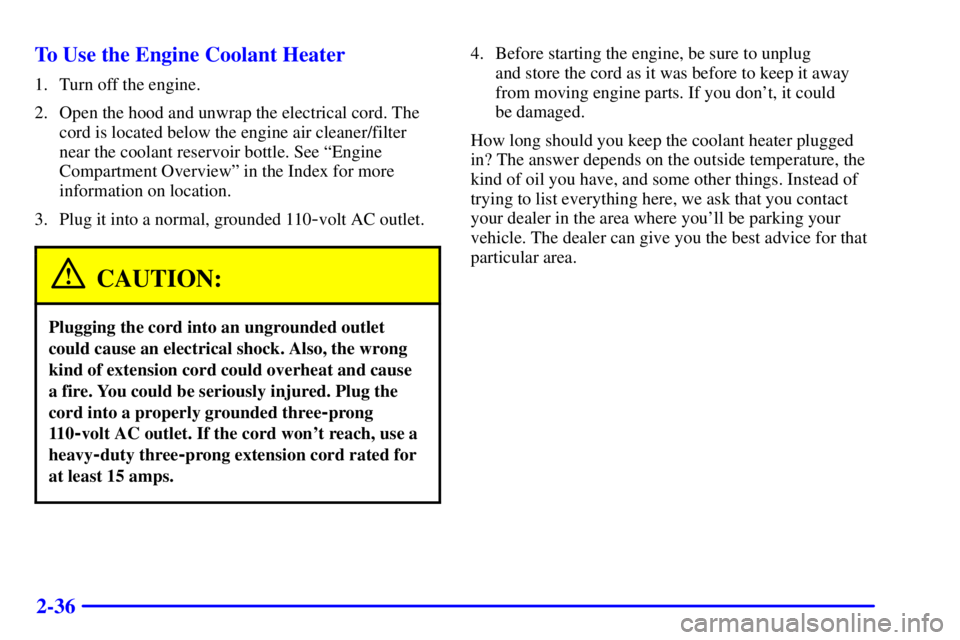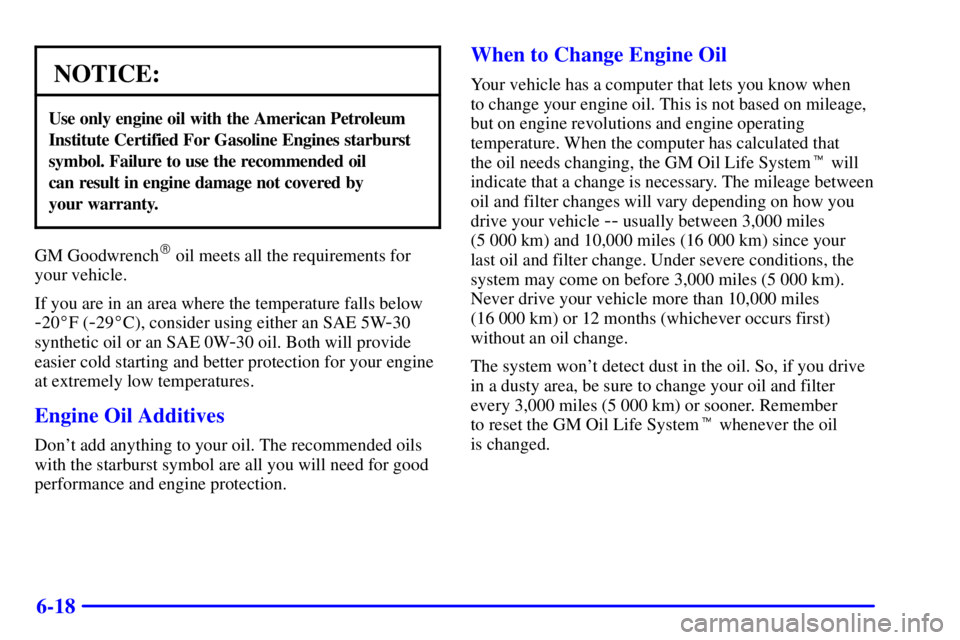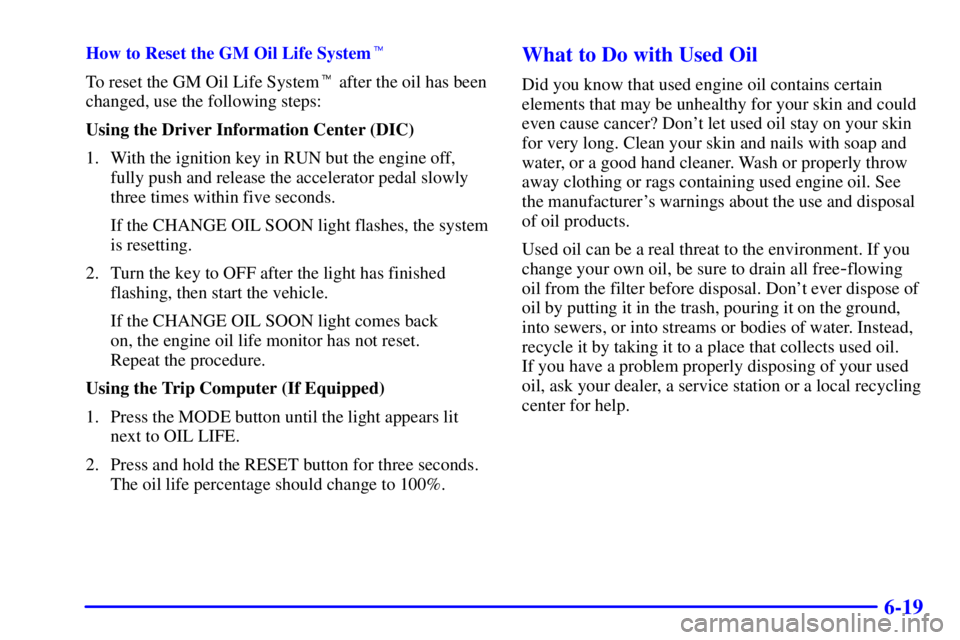Page 6 of 373
iv
Table of Contents (cont'd)
Maintenance Schedule Service and Appearance Care
Section
7
Section
6
Scheduled Maintenance
Owner Checks and Services
Periodic Maintenance InspectionsRecommended Fluids and Lubricants
Maintenance Records
Fuel
Checking Fluids and Lubricants
GM Oil Life System™
Engine Air Cleaner/Filter
Brakes
Bulb ReplacementWindshield Wiper Blade Replacement
Tires and Wheels
Appearance Care
Electrical System/Fuses and Circuit Breakers
Capacities and Specifications
Normal Maintenance Replacement Parts
Page 105 of 373

2-36 To Use the Engine Coolant Heater
1. Turn off the engine.
2. Open the hood and unwrap the electrical cord. The
cord is located below the engine air cleaner/filter
near the coolant reservoir bottle. See ªEngine
Compartment Overviewº in the Index for more
information on location.
3. Plug it into a normal, grounded 110
-volt AC outlet.
CAUTION:
Plugging the cord into an ungrounded outlet
could cause an electrical shock. Also, the wrong
kind of extension cord could overheat and cause
a fire. You could be seriously injured. Plug the
cord into a properly grounded three
-prong
11 0
-volt AC outlet. If the cord won't reach, use a
heavy
-duty three-prong extension cord rated for
at least 15 amps.
4. Before starting the engine, be sure to unplug
and store the cord as it was before to keep it away
from moving engine parts. If you don't, it could
be damaged.
How long should you keep the coolant heater plugged
in? The answer depends on the outside temperature, the
kind of oil you have, and some other things. Instead of
trying to list everything here, we ask that you contact
your dealer in the area where you'll be parking your
vehicle. The dealer can give you the best advice for that
particular area.
Page 263 of 373

6-
6-1
Section 6 Service and Appearance Care
Here you will find information about the care of your vehicle. This section begins with service and fuel information,
and then it shows how to check important fluid and lubricant levels. There is also technical information about your
vehicle, and a part devoted to its appearance care.
6
-2 Service
6
-3 Fuel
6
-5 Fuels in Foreign Countries
6
-5 Filling Your Tank
6
-8 Filling a Portable Fuel Container
6
-8 Checking Things Under the Hood
6
-13 Engine Oil
6
-20 Engine Air Cleaner/Filter
6
-21 Supercharger Oil
6
-22 Automatic Transaxle Fluid
6
-26 Engine Coolant
6
-29 Radiator Pressure Cap
6
-30 Power Steering Fluid
6
-32 Windshield Washer Fluid
6
-33 Brakes
6
-37 Battery
6
-38 Bulb Replacement
6
-46 Windshield Wiper Blade Replacement
6
-47 Tires6
-55 Appearance Care
6
-55 Cleaning the Inside of Your Vehicle
6
-57 Care of Safety Belts
6
-59 Cleaning the Outside of Your Vehicle
6
-60 Cleaning Aluminum or Chrome-Plated
Wheels (If Equipped)
6
-60 Cleaning Tires
6
-61 Sheet Metal Damage
6
-61 Finish Damage
6
-61 Underbody Maintenance
6
-61 Chemical Paint Spotting
6
-62 GM Vehicle Care/Appearance Materials
6
-63 Vehicle Identification Number (VIN)
6
-63 Service Parts Identification Label
6
-64 Electrical System
6
-70 Replacement Bulbs
6
-70 Capacities and Specifications
6
-71 Normal Maintenance Replacement Parts
Page 272 of 373
6-10 Engine Compartment Overview
When you open the hood of the 3100 V6 (Code J) engine, you'll see:
A. Windshield Washer Fluid
B. Battery
C. Radiator Fill Cap
D. Engine Coolant ReservoirE. Power Steering Fluid Reservoir
F. Engine Oil Fill Cap
G. Engine Oil DipstickH. Automatic Transaxle
Fluid Dipstick
I. Brake Fluid Reservoir
J. Engine Air Cleaner/Filter
Page 273 of 373
6-11
When you open the hood of the 3800 V6 (Code K) engine, you'll see:
A. Windshield Washer Fluid
B. Battery
C. Radiator Fill Cap
D. Engine Coolant ReservoirE. Power Steering Fluid Reservoir
(low in engine compartment)
F. Engine Oil Fill Cap
G. Engine Oil DipstickH. Automatic Transaxle
Fluid Dipstick
I. Brake Fluid Reservoir
J. Engine Air Cleaner/Filter
Page 274 of 373
6-12
When you open the hood of the 3800 V6 Supercharged (Code 1) engine, you'll see:
A. Windshield Washer Fluid
B. Battery
C. Radiator Fill Cap
D. Engine Coolant ReservoirE. Power Steering Fluid Reservoir
(low in engine compartment)
F. Engine Oil Fill Cap
G. Engine Oil DipstickH. Automatic Transaxle
Fluid Dipstick
I. Brake Fluid Reservoir
J. Engine Air Cleaner/Filter
Page 280 of 373

6-18
NOTICE:
Use only engine oil with the American Petroleum
Institute Certified For Gasoline Engines starburst
symbol. Failure to use the recommended oil
can result in engine damage not covered by
your warranty.
GM Goodwrench� oil meets all the requirements for
your vehicle.
If you are in an area where the temperature falls below
-20�F (-29�C), consider using either an SAE 5W-30
synthetic oil or an SAE 0W
-30 oil. Both will provide
easier cold starting and better protection for your engine
at extremely low temperatures.
Engine Oil Additives
Don't add anything to your oil. The recommended oils
with the starburst symbol are all you will need for good
performance and engine protection.
When to Change Engine Oil
Your vehicle has a computer that lets you know when
to change your engine oil. This is not based on mileage,
but on engine revolutions and engine operating
temperature. When the computer has calculated that
the oil needs changing, the GM Oil Life System� will
indicate that a change is necessary. The mileage between
oil and filter changes will vary depending on how you
drive your vehicle
-- usually between 3,000 miles
(5 000 km) and 10,000 miles (16 000 km) since your
last oil and filter change. Under severe conditions, the
system may come on before 3,000 miles (5 000 km).
Never drive your vehicle more than 10,000 miles
(16 000 km) or 12 months (whichever occurs first)
without an oil change.
The system won't detect dust in the oil. So, if you drive
in a dusty area, be sure to change your oil and filter
every 3,000 miles (5 000 km) or sooner. Remember
to reset the GM Oil Life System� whenever the oil
is changed.
Page 281 of 373

6-19
How to Reset the GM Oil Life System�
To reset the GM Oil Life System� after the oil has been
changed, use the following steps:
Using the Driver Information Center (DIC)
1. With the ignition key in RUN but the engine off,
fully push and release the accelerator pedal slowly
three times within five seconds.
If the CHANGE OIL SOON light flashes, the system
is resetting.
2. Turn the key to OFF after the light has finished
flashing, then start the vehicle.
If the CHANGE OIL SOON light comes back
on, the engine oil life monitor has not reset.
Repeat the procedure.
Using the Trip Computer (If Equipped)
1. Press the MODE button until the light appears lit
next to OIL LIFE.
2. Press and hold the RESET button for three seconds.
The oil life percentage should change to 100%.What to Do with Used Oil
Did you know that used engine oil contains certain
elements that may be unhealthy for your skin and could
even cause cancer? Don't let used oil stay on your skin
for very long. Clean your skin and nails with soap and
water, or a good hand cleaner. Wash or properly throw
away clothing or rags containing used engine oil. See
the manufacturer's warnings about the use and disposal
of oil products.
Used oil can be a real threat to the environment. If you
change your own oil, be sure to drain all free
-flowing
oil from the filter before disposal. Don't ever dispose of
oil by putting it in the trash, pouring it on the ground,
into sewers, or into streams or bodies of water. Instead,
recycle it by taking it to a place that collects used oil.
If you have a problem properly disposing of your used
oil, ask your dealer, a service station or a local recycling
center for help.